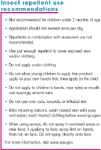Dermatoses of summer
Scant clothing, intense solar radiation, high heat and humidity, and burgeoning bug populations put children at risk for summertime dermatoses. The pediatric clinician must be able to distinguish innocent skin eruptions from potentially life-threatening disorders, and to counsel children and parents about skin protection during the summer.

Key Points
SUMMER BITES & INFESTATIONS
Papular Urticaria
Although insect and tick-borne bites and diseases occur year-round, the prevalence peaks in the summer when conditions are more favorable for insect activity and opportunities for exposure are increased. Insect bites, resulting in papular urticaria, are a common phenomena, presenting as pruritic, often grouped, pink urticarial papules. Excoriation from scratching is common, and may result in secondary infection, most often with Staphylococcus epidermidis or S. aureus. Vesicobullous or nodular lesions are not uncommon, but can confuse the diagnosis at times. Notably, often only one family member is affected, as most clinical findings are a result of the patient's immune response to the bite, rather than the bite itself. Papular urticaria usually affects younger children, and children later outgrow the reaction. Fleas and bedbugs are the most common causes, but any insect can cause the reaction.1 Treatment should be directed at limitation of exposure when possible.

CONTACT DERMATITIS
Poison Ivy, Poison Oak, Poison Sumac
As the skin findings for all three are the same, they are discussed together. Poison ivy is the most common allergic contact dermatitis in the US, affecting about half the population. Yet only about 15% of those with atopic dermatitis (eczema) are susceptible to the rash. It most often appears within two days of exposure as pink papules and vesicles arranged in linear streaks, from contact with Rhus oleoresin. Large plaques may occur from indirect contact with clothing or pet fur, and aerosolized exposure from fire or a lawnmower can result in widespread rash, often affecting all exposed skin including the face. Facial and genital swelling can be impressive. The rash appears first in skin with the heaviest antigen load, and then in areas with less initial antigen exposure. Progression is due to the amount of resin deposited on different areas of the skin, and is influenced by epidermal thickness.2 Washing the skin can be helpful, but only if done within 20 minutes of exposure, after which point the antigen is fixed to the skin. The rash peaks in one to 14 days. "Black spot" or "black dot" poison ivy is less often seen but classic for poison ivy exposure, and is a combined allergic and irritant contact dermatitis caused by oxidized resin that turns black on the skin.
Prevention is key, and treatment is symptomatic. Topical corticosteroids (Class III to VI), calamine lotion (not Caladryl), and cool compresses are often helpful. In severe cases, oral corticosteroids (1–2 mg/kg/day) have a role, but must be continued for at least seven to 10 days before tapering (minimum of three weeks total). Commonly prescribed dosepacks will result in rebound reactions, which can be as bad or worse as the initial eruption.
Recognize & Refer: Hemangiomas in pediatrics
July 17th 2019Contemporary Pediatrics sits down exclusively with Sheila Fallon Friedlander, MD, a professor dermatology and pediatrics, to discuss the one key condition for which she believes community pediatricians should be especially aware-hemangiomas.